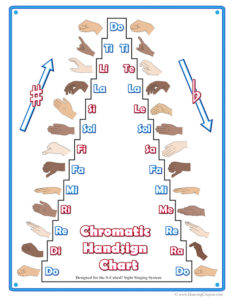This is the 5th and final posting in the five-part series called “Why Won’t My Middle School Choir Sing?”
To start with the first reason, click here!
Reason #5:
We don’t know how to introduce music.
It is possible to turn this age group against a new piece of music in the three minutes of introducing it to them for the first time.
I struggled for years with finding good ways to introduce a new piece in a way that would peak their interest and excite them to want to dig into the song and make it great.
During my first years in the classroom, I kept hearing the voices of my college professors in my head: “Don’t teach by rote! Make them literate!”
I couldn’t figure out the balance of teaching “by rote” and teaching literacy when I was introducing a new song to beginners.
Ultimately, the guiding force for me became the energy in the room.
Like comedians in a comedy club, we can tell when we are bombing. Kids this age are transparent, and it is not easy for them to hide how they feel when we are failing while we teach.
If you feel boredom and frustration from your students when you teach a new song, it’s probably time to try a new approach to the introduction of your new music.
In the early days of my career, when I introduced a new song to my students, my teaching process was way too slow. I constantly demanded that they figure things out on their own yet I had not systematically taught them the tools they needed to do it. I failed to see that there were ways to teach new music that were much quicker and more fun and included developing their ears using techniques that some might call “teaching by rote”.
I was teaching sight singing regularly to my students, but I failed to realize how long it takes for their sight singing abilities to catch up to their ability to sing a song that may be quite difficult.

My students just wanted to sing, and all I was doing was stopping to talk, or to complain about how they missed something in the music or explain things they simply were not ready or interested in learning yet. I tried to teach everything about the application of sight singing techniques at once as they learned a new piece, and as a result, they were actually learning very little about sight singing.
..and I talked…and talked…and talked.
I finally asked myself, “What exactly is ‘teaching by rote’? And who defines it? And how can I actually USE “rote teaching” to give me opportunities to vary my teaching techniques while helping them become better musicians as they learn to use their ears better and learn to recognize form?
I had to let go of some of those voices in my head from my college professors. I had to focus on finding ways to help my beginning students enjoy the process of learning a new song.
If they journey isn’t an enjoyable and rewarding one, programs shrink.
Most of my students had never taken a private piano lesson, so I had to work to find ways to keep them engaged during the learning of a new piece while instilling, unveiling and building the important skill sets they needed for sight singing. Literacy is key to their continued growth and involvement as choral music singers, but finding the proper balance wasn’t easy for me.
Now, I take about 10-15 minutes per day to focus specifically on theory and sight singing, and I use the rest of the time while I am teaching repertoire using rote techniques mixed with literacy teaching. If there is an opportunity to connect some dots from the sight singing lesson of that day, I do it.
I started allowing my beginners to listen to recordings on the first day of learning a new piece, and I turned it into a fun form exercise to help them develop their ears. When working on form with my beginners, however, I learned that I needed to avoid turning it into a sophomore college theory class exercise that uses terms like “ABA” form etc. When I tried that, the eyes of my beginners glazed over. Instead, I worked to find ways to teach form that were engaging for beginners in this age group.
Here is a form exercise I often do with my beginners:
While they are listening to a piece of music for the first time, I ask them to draw pictures to represent new musical ideas when they hear them. I encourage them to be as crazy and creative with their pictures as they want as long as they indicate the shape and form of the song. If the chorus happens twice, but the second chorus has a different ending than the first, for example, their pictures should indicate the difference. If they drew a smiley face for the first chorus, then they might draw a smiley face and add hair to the drawing when they hear the chorus that has a slightly different ending.
It is hilarious to see some of the drawings that they create. When I call them up to share their drawings on the Smart Board in front of the class, there is lots of laughter! The best part is that they get to listen to the song multiple times while they are creating the pictures. We can teach many good listening skills during an exercise like this one when we teach them to listen to the smallest differences in various phrases and to indicate those differences in their pictures.
Creating excitement over a new piece of music is critical. If the students “check out” on a piece because we’ve introduced it poorly, it’s really difficult to get them to give the song a chance. The last thing we can be with our middle school students is boring. It’s a nail in the coffin of our programs. We must be open to varied teaching techniques, and we must constantly work to find ways to help them stay engaged and excited as we ease them into the learning of a new song.
Dale Duncan is the creator of the S-Cubed Middle School Sight Singing Program for Beginners
Click here to see what people are saying about S-Cubed!
Click here to go to my YouTube Channel with free teaching tips and ideas.




Earlene Rentz says
Dale, do you ever create Rehearsal Preparation Sheets (RPS)? I read your process…so much wisdom here. I am wondering if supplementary materials like an RPS would fit into your structure somewhere? Several years ago, I got the idea for these materials from Gayle Box, a Texas middle school music educator. I have several of these on my website (www.earlenerentz.com) that are sent as complimentary materials with a purchase. These sheets are directly related to the piece being studied, and might supply a step right after the rote components before going to the actual notation.
Dale Duncan says
Thank you for the kind words. I do not use the process you described, but I love learning new things to help keep the energy going in my classroom. I will check out your resources!